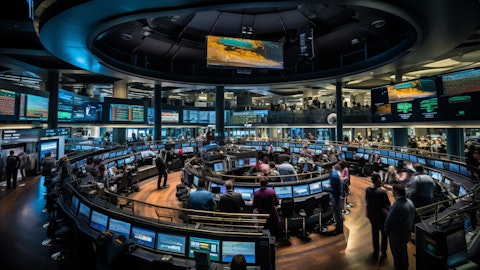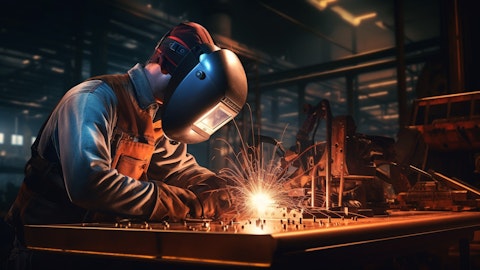Timna Tanners: Got it. Okay, that’s helpful. Yes, the futures market is tiny. I get it, it’s just something people look at. So I just wanted to ask about that. Just to clarify on the last…
Lourenco Goncalves: Timna, people like me need to talk like I talk to make sure that the people that look stop looking. Because if they stop looking, it’s a good, good, good start, you know. And if people like you help, life will be a lot easier, because you’re knowledgeable. You know that, that thing sucks. You know that, that thing is useless. You know that, that thing is just a thing for people to sell the newsletters every day. It’s absolutely useless. There’s a lot of wealth being destroyed by the use of these things. It’s about time for us as a business community to understand that it’s fair to make money. Let’s make money doing things that are constructive. And that thing is destructive, is not constructive. I’m sorry I interrupted you. Go ahead please, Timna.
Timna Tanners: No, that’s okay. I’ll leave it there, Lourenco. Thanks again.
Lourenco Goncalves: Thank you. Don’t forget about the resetting thing. It’s serious.
Operator: Thank you. Our next question comes from a line of Tristan Gresser with BNP Paribas Exane. Please proceed with your question.
Tristan Gresser: Yes, hi. Good morning and thank you for taking my questions. The first question is on the scrap market. In your prepared remarks, you mentioned some artificial moves in the scrap market and probably refer to the January settlement. So I would be keen to have your view on what you think happened and what do you think needs to happen in the market to be what you call fair? That’s my first question. Thank you.
Lourenco Goncalves: Good morning, Tristan. Yes, you already answered your own question. Yes, that’s the January thing. In a market that is clearly undersupplied with prime scrap? Why is it unsupplied with prime scrap? Let’s see. Manufacturing in the United States is until the initiative that has happened in the last few years, the IRA, the infrastructure bill, and et cetera., all these things that are going on right now and will bear fruit in the future, manufacturing is shrinking. With manufacturing shrinking, the generation of prime scrap is shrinking. At the same time, the mini mills continue to build capacity and capacity to produce flat rolled steel, it is prime scrap. There’s no other way to get there, particularly with mini mills that don’t own or own assets.
So they can’t use enough of metallics, enough of substitutes, so they have to use prime scrap. So the prime scrap is shrinking because manufacturing is shrinking. It has not started to grow just yet. And the demand for scrap is increasing. What’s the trend of the price, is up. So we can’t have a drop like the one that was attempted to happen in January, because it was just a head fake. The final numbers were not the initial numbers. The initial numbers were one trade, is one trade that only happens here in Ohio. And we have already identified how the trade goes. So what’s the solution? Just let supply and demand work. Because if supply and demand doesn’t work and this thing continues to happen time and time again, this is a country of loss.
You cannot collude to make prices go in the direction you want. You’re going to have real competition. You’re going to have the forces of supply and demand prevail, because that’s what the letter of the law will support. I hope you understand my point.
Tristan Gresser: Yes, that’s very clear. Thank you. And my second question is on the surcharge or the premium. I think, you mentioned the successful implementation of the surcharge in the contract. So what is the volume involved for those premiums and what is it corresponding in terms of carbon intensity? I think you previously mentioned a $40 premium and I believe you will move further down in carbon intensity for you, BF, BOF. So do you believe this premium could increase with time or it should be relatively stable in 2024? Thank you.
Lourenco Goncalves: Yes, in 2024, it will be stable, and that’s the number. The surcharge called Cliffs H, it’s applied to all of our automotive clients at this point. And some of the clients outside of automotive that have the need and the desire to get a steel that is environmentally compliant. It’s easy for them to not only pay for it, but also to pass along, which they haven’t started yet. But it should be, for a car, for example, assuming that a car has one ton of steel, it would be $40 per car. So it will not be significant in a big scheme of things. So all of our automotive contracts with multiple millions of tons, let’s call 5 million tons, is a significant number. So it’s not irrelevant. That’s why we’re spending time discussing in this call.
The next step will be when we have green hydrogen available, which we don’t have today. Our trials with hydrogen are being done with what we have, gray hydrogen. And gray hydrogen is good enough for us to make sure that, metallurgically, inside the blast furnace, the hydrogen works as a reductant. And that’s what we’re proving right now. We are proving to ourselves that we are on the right track. We are very excited that we are on the technological right track. But what we are aiming to have is green hydrogen. And when we have green hydrogen available, we’re going to be at the Cliffs H max level. In the meantime, any hydrogen, green, gray, pink, whatever, we can get our hands around, that we can use to enrich natural gas, we are going to start using.
And when we get to a level that we can consider to really reducing CO2 emissions, due to the use of any type of hydrogen that is a positive for CO2 emissions and we can prove the numbers to the world in our sustainability reports, we are going to go to the Cliff H2 surcharge. That will be higher than Cliffs H. So in summary, Cliffs H now is $40 per ton. When we have hydrogen available enough to use hydrogen to enrich natural gas, we’re going to go to Cliff H2, and when you get to green hydrogen, which we fully expect it to be in the next several years, but before 2030, we’re going to be at the Cliff H max. But that’s the route we’re going. But we are doing this to get paid, not to brag about like 99.9% of the CEOs that talk about environmental, they have, they just want this thing to go away one day and they don’t need to talk about it anymore.
But they don’t even know what they’re talking about.
Tristan Gresser: All right. That’s very clear. Thank you.
Lourenco Goncalves: Thank you.
Operator: Thank you. [Operator Instructions] Our next question comes from the line of Bill Peterson with P. Morgan. Please proceed with your question.
Bill Peterson: Yes. Hi, good morning, and thanks for taking our questions. First question I wanted to kind of come back to the fundamentals and you know your outlook. So if we think you know the current views of the steel market as you see it given that it looks like pricing may have already peaked this year, compared to last year, which is a little bit later in the year, maybe March, April? And then, if you can touch on the customer inventory, you’re seeing relative strength in the value added steel products over HRC. And then specifics for you, as we think about the first quarter, how should we think about the product mix, you know, given the step down and coated volumes during the fourth quarter?





